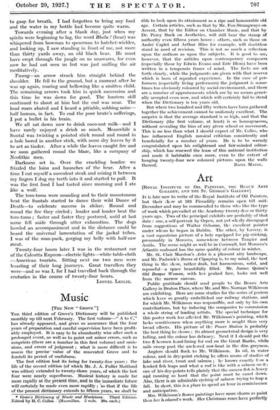Art
[ROYAL INSTITUTE OF OIL PAINTERS, THE BEAUX ARTS GALLES.Y, AND THE ST. GEORGE'S GALLERY] IT is late now to write of the Royal Institute of Oil Painters, but their ih ow at 195 Piccadilly remains open till mid- December and may be commended to those who like the type of work which prevailed at the Academy twenty-five or thirty years ago. Two of the principal exhibits are probably of that date : one, a self-portrait by Orpen, not yet wholly disengaged from suggestions of Walter Osborne, the excellent painter under whom he began in Dublin. The other, by Lavery, is a vast equestrian picture of a lady equipped for pig-sticking, presumably in Morocco, somewhere between Tangier and Arzila. The scene might as well be in Cornwall, but Morocco's Atlantic seaboard has the same quality of colour in winter.
Mr. St. Clair Marston's Arles is a pleasant airy landscape, and Mr. Padwick's Barns at Clymping is, to my mind, the best thing in the show, rather drab, but harmonious, solid, and reposeful—a space beautifully filled. Mr. James Quinn's Old Basque Woman, with her peaked face, looks out well from the narrow canvas.
Public gratitude should send people to the Beaux Arts
Gallery in Bruton Place, where Mr. and Mrs. Norman Wilkinson are exhibiting. Here arc some studies for the series of posters which have so greatly embellished our railway stations, and for which Mr. Wilkinson was responsible, not only by his own contributions, but by inducing the companies to commission a whole string of leading artists. The special technique for this poster work has affected Mr. Wilkinson's painting, which lacks sensitiveness when anything more is sought than very broad effects. His picture of the Power Station is probably the best thing he shows ; its almost geometrical design is very telling, and the colour has delicacy. Next it I should put the two fl hermen hand-lining for cod on the Great Banks, while sails sweep past the anchored row-boat in the dim greyness.
Anglers should flock to Mr. Wilkinson. In oil, in water colour, and in dry-point etching he offers scores of studies of lake and river, trout and salmon ; he knows exactly how a hooked fish leaps and what a rod' is like with a salmon on it: one of his dry-points tells plainly that the unseen fish is heavy and running so hard that the point must be eased down. Also, there is an admirable etcAing of salmon trying to leap a fall. In short, this is a place to spend an hour in reminiscence and anticipation. Mrs. Wilkinson's flower paintings have more charm as paint than her hisband's work. Her Christmas roses have perfectly
the flower's mother-of-pearl quality, yet somehow the bowl and the background do not come together to make this so good a picture as the little posey of polyanthus which gets and deserves the place of honour.
At the St. George's Gallery, off Hanover Square, the Golden Cockerel Press gives us specimens of some of the best modern printing and illustration. Yet the Greek type (used in the Lucian) lacks the solidity, dignity, and strength that have been so well attained in the Roman founts. Among the illustrators, Mr. Eric Gill is well known everywhere, and Mr. David Jones, working also with mediaeval inspiration, has even more fertility of invention. Mr. Jon Farleigh gets a richness of humour as well as of tone into the heavy strokes of his wood- cuts for Swift's essays. But there is quite another method displayed in the filmy tracery of Mr. Gill's illustrations to Enid Clay's Sonnets and Verses ; while M. Laboureur, with again a wholly different use of line, gets the very spirit of Sterne's persiflage. In Lady Mabel Annesley's illustrations for Burns the tiny woodcut of a fiddler seated on a table and playing to two or three country folk is perfect both in design and suggestion. But Mr. Robert Gibbings himself, the Director of the Cockerel Press, exceeds all his companions in the power and variety of his work. One little vignette for Thoreau seems to give at a glance the whole history of the house and household ; a nude figure kneeling on the shore while a boat approaches, is a wordless cry of expectancy.
LEMON GREY.



























































 Previous page
Previous page